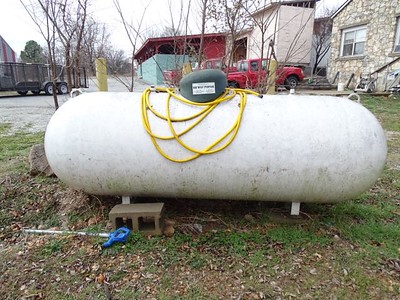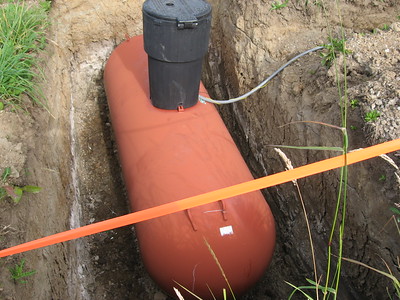
The cost to install a 250-gallon propane tank can vary significantly based on various factors. Generally, the national average cost for an above-ground 250-gallon propane tank installation ranges from $500 to $1,200. However, the final cost may be higher or lower depending on the following factors:
- Location: The cost of labor and materials can vary greatly depending on where you live. Some regions have higher labor rates and material costs, which can affect the overall cost of the installation.
- Site preparation: If your property requires additional work, such as clearing or leveling the land, excavating, or building a retaining wall, these costs will need to be factored into the overall project cost.
- Permits and inspections: Depending on your local regulations, you may need to obtain permits and schedule inspections for the installation. These costs can add to the overall expense of the project.
- Tank type: Above-ground tanks are typically less expensive to install compared to underground tanks because they don’t require excavation and are easier to access. However, above-ground tanks may be less aesthetically pleasing and can be more susceptible to weather-related damages. You can buy this tank in several location.
- Additional equipment: The installation may require extra materials such as gas lines, regulators, valves, and fittings. The cost of these components will also need to be considered.
- Professional installation: Hiring a licensed and experienced propane tank installer is essential for safety and proper functioning. The cost of labor for installation can vary depending on the contractor’s experience, reputation, and local rates.
- Maintenance and monitoring: Some companies may offer maintenance and monitoring services for your propane tank. These services could include regular inspections, refilling, and repairs. While these services may not be directly related to the installation cost, they are important to consider when choosing a propane provider.
To get an accurate cost estimate for installing a 250-gallon propane tank at your property, it’s recommended to contact multiple local propane providers and obtain quotes. Be sure to ask for a detailed breakdown of the costs involved in the installation, as well as any additional services they may offer. This will ensure you get the best value and a quality installation that meets your needs.
How Can You Save Some Bucks on Installation
There are several ways you can save money on propane tank installation without compromising on safety or quality. Here are some tips to help you reduce the overall cost:
- Obtain multiple quotes: Contact several propane providers in your area to get detailed quotes for the installation. Comparing multiple quotes will allow you to find the best deal and ensure you’re getting a fair price.
- Bundle services: Some propane providers may offer discounts if you bundle the installation with other services, such as regular propane deliveries or a maintenance plan. This can help you save money on the installation as well as long-term operating costs.
- Look for promotions or discounts: Propane providers may occasionally offer promotions or discounts on installations. Keep an eye out for special offers or ask your provider if they have any current deals available.
- Opt for an above-ground tank: Above-ground propane tanks are generally less expensive to install than underground tanks. If aesthetics and local regulations permit, choosing an above-ground tank can save you money on installation costs.
- DIY site preparation: If you have the necessary skills and equipment, you can save money by handling some of the site preparation work yourself, such as clearing the area or leveling the land. However, always prioritize safety and consult with your propane provider to ensure you are not compromising the quality of the installation.
- Choose a smaller tank: If your propane usage is relatively low or you have a smaller home, you may be able to opt for a smaller propane tank, which will typically cost less to install. Discuss your usage requirements with your propane provider to determine the appropriate tank size for your needs. You have to consider also if 250-gallon tank is enough for your home.
- Seasonal timing: The demand for propane installations may fluctuate seasonally. Scheduling your installation during a less busy time of year, such as spring or fall, may result in lower labor costs and faster installation times.
Remember that while it’s essential to save money, you should never compromise on safety or the quality of the installation. Always work with licensed and reputable professionals to ensure your propane tank installation is safe and reliable.
What are the Factors that Affect the Installation Cost
Several factors can affect the installation cost of a propane tank. Some of the primary factors include tank size, distance from the house, and whether the tank is installed underground or above ground:
- Tank size: The size of the propane tank you choose will directly impact the cost of installation. Larger tanks require more materials and labor to install, leading to a higher overall cost. Smaller tanks will generally be less expensive to install.
- Distance from the house: The distance between the propane tank and your house can affect the cost of installation. A greater distance will require more materials (such as piping) and labor to connect the tank to your home, increasing the overall cost. If your tank needs to be placed further away due to local regulations or property constraints, you may face higher installation costs.
- Above ground vs. underground: The choice between an above-ground or underground propane tank installation can significantly impact the cost. Above-ground tanks are generally less expensive to install because they do not require excavation and are easier to access for maintenance and refilling. However, they may be less aesthetically pleasing and more susceptible to weather-related damage. Underground tanks, on the other hand, require excavation and additional site preparation, which can increase the installation cost. These tanks are hidden from view and better protected from the elements, but they can be more difficult to access for maintenance.
In addition to these factors, other aspects such as local labor rates, site preparation needs, permits and inspections, and the contractor’s experience can also influence the overall cost of the propane tank installation. It’s essential to obtain multiple quotes from local propane providers to ensure you get the best value and a quality installation that meets your needs.
Above ground vs. Underground
The cost of installing an above-ground propane tank versus an underground propane tank can vary significantly due to different installation requirements and site preparation needs. Here’s a comparison of the costs associated with each type of installation:
Above-ground propane tank installation:
Above-ground tanks are generally less expensive to install because they do not require excavation. The installation process is simpler and less labor-intensive, which translates to lower labor costs. The cost of an above-ground installation for a 250-gallon propane tank, as mentioned earlier, typically ranges from $600 to $1,200.
However, above-ground tanks are more visible and can be considered less aesthetically pleasing. They may also be more susceptible to weather-related damage and potential vandalism. Above-ground tanks may also require additional safety measures, such as fencing or barriers, depending on local regulations, which can add to the overall cost.
Underground propane tank installation:
Underground tanks require excavation and additional site preparation, which can increase the installation cost. The process involves digging a hole, placing the tank in the hole, and backfilling it with the appropriate material. This requires more time and labor, as well as specialized equipment, which translates to higher labor costs.
The cost of installing an underground propane tank can vary greatly depending on factors such as tank size, site preparation needs, and local labor rates. However, you can generally expect the cost to be higher than that of an above-ground installation. For a 250-gallon underground propane tank, the installation cost can range from $1,500 to $3,000 or more.
While underground tanks are hidden from view and better protected from the elements, they can be more challenging to access for maintenance and refilling. Additionally, special corrosion protection measures, such as cathodic protection, might be necessary to prevent the tank from deteriorating over time, adding to the overall cost.
While above-ground propane tank installations are typically less expensive, underground installations offer the advantage of being hidden from sight and better protected. The choice between the two largely depends on your budget, aesthetic preferences, and local regulations. Be sure to obtain multiple quotes from local propane providers to ensure you get the best value and a quality installation that meets your needs.
In Conclusion
Installing a propane tank at your property involves several factors that can influence the overall cost, such as tank size, distance from the house, and whether it’s an above-ground or underground installation. Additional costs to consider include labor, permits, regulators, piping, and site preparation. To save money on the installation, you can obtain multiple quotes, bundle services, look for promotions, opt for an above-ground tank, handle some site preparation yourself, choose a smaller tank, or schedule the installation during a less busy season.
However, it’s crucial not to compromise on safety or the quality of the installation. Always work with licensed and reputable professionals to ensure your propane tank installation is safe, reliable, and meets local regulations. By carefully considering your options and comparing quotes from multiple providers, you can find the best value for your propane tank installation while still prioritizing safety and quality.

Jeremy is a highly experienced professional propane technician with over 21 years of experience in the industry. Throughout his career, he has gained extensive knowledge and expertise in propane gas installation, maintenance, and repair, as well as in ensuring safety and compliance with industry standards. Mike has worked with various residential, commercial, and industrial clients, providing top-notch services and solutions to meet their propane needs. He is dedicated to his craft and passionate about delivering exceptional service to his clients.



